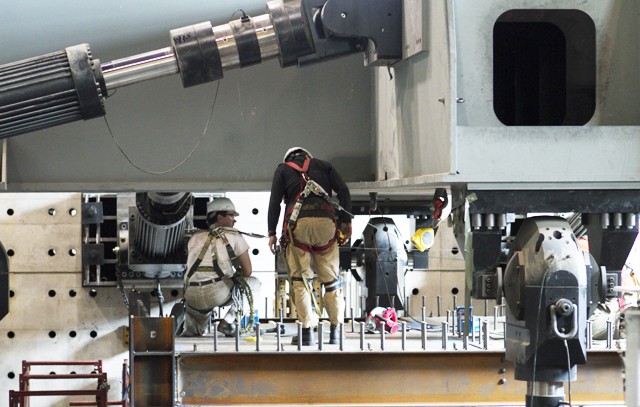Earthquakes take place along plate edges and along faults all over the world, but in April, one will take place on the University of Minnesota campus. A laboratory at the University will test the effect an earthquake has on a building frame used worldwide as part of an international study. The differences in the stability of structures were made clear in recent earthquakes in Haiti and Chile. âÄúYou see how much devastation is in Haiti, and you compare it to the earthquake in Chile, which was a much bigger earthquake,âÄù said Dr. Carol Shield, a lead researcher in the study. âÄúIt didnâÄôt affect nearly as much.âÄù Shield said the tests performed in the laboratory can help develop materials that prevent catastrophes like the damage in Haiti from reoccurring. âÄúThe potential for saving lives is huge,âÄù Shield said. The Multi-Axial Subassemblage Testing (MAST) Laboratory is one of only a few labs in the world that can test a fully constructed buildingâÄôs ability to handle an earthquake, and itâÄôs being used in a study testing steel, concentrically braced frames used in buildings all over the world. âÄúInternational Hybrid Simulation of TomorrowâÄôs Steel Based FramesâÄù is an international study with the University of Washington; University of California, Berkeley; and the National Taiwan University working with the University of Minnesota. The study is looking at the brace used in the frame, which is designed to disperse the energy from an earthquake to protect the buildingâÄôs overall structure. However, when these braces are installed into the overall frame of the building, the brace tends to be less effective in dispersing an earthquakeâÄôs energy, according to Keith Palmer, a graduate student in the Department of Civil Engineering. Palmer, who is a researcher on the project, said the study aims to improve the connection of the brace. âÄúWe are trying to ensure the performance of the whole building is as satisfactory as the single brace,âÄù Palmer said. The UniversityâÄôs role in the study comes after other participating institutions have been performing tests on pieces of the structure for more than 10 years, Palmer said. The research of the collaborating institutions formed a brace connection that could work better when connected to an overall structure, Palmer said, and the MAST Laboratory will reveal if it actually does. âÄúThis is the culmination of the prior work done in the study,âÄù Palmer said. Dr. Charles Roeder, professor in the Department of Civil and Environmental Engineering at the University of Washington and a researcher in the study, said the facility will perform one of its last tests in the study, and it will reveal if the brace works in a real-life setting. âÄúThis is a confirmation test,âÄù Roeder said. âÄúWe can tell if this really works in a three-dimensional system.âÄù The ability to test an actual three-dimensional structure is unique, Shield said. âÄú[The laboratory] lets you test a building or a bridge in a much more realistic form,âÄù Shield said. Palmer said the laboratory mimics the unpredictable behavior of an earthquake across an entire building. âÄúAn earthquake doesnâÄôt just hit in one direction,âÄù Palmer said. âÄúIt is going to be hitting the building from all over, and we use this facility for that reason.âÄù What gives the laboratory the ability to imitate an earthquake is the mulit-axial subassemblage testing system. The system attaches to the top of the structure being tested, and it compresses or stretches structures with the same type of distress it would actually undergo in an earthquake. In April, the laboratory will put their structure, which is 10 years in the making, through this kind of distress. However, Shield said it wonâÄôt end up being a thrilling show. âÄúIt is like watching paint dry,âÄù Shield said. Instead of taking the short length of time an earthquake lasts, the structure will go through distress that can last for up to three days, Shield said. Although some critics argue this is unrealistic, Shield said the structure undergoes the same stress that it would during an earthquake. In fact, Shield said the extended event allows scientists to better document the damage being caused to the structure. For the people working on the project, the event in April will prove to be a little more exciting than watching paint dry. Civil engineering senior Gannon Stromquist-LeVoir, who is one of four undergraduates working in the laboratory, said the anticipation has been building since he began with the project last spring. âÄúWe have been working at the laboratory every day for three months,âÄù Stromquist-LeVoir said. âÄúThe buildup is starting to get huge.âÄù The work Stromquist-LeVoir and other participants at the laboratory have put into the study is a large expense that prevents the study from performing the test more than once, according to Roeder. âÄúIt would be nice to perform this test half a dozen times; however, the cost just doesnâÄôt permit that,âÄù Roeder said. The length it takes the structure to fail or collapse, which depends on the quality of the frame, determines the time of the earthquakeâÄôs simulated stress in the actual testing, Shield said. She said structures built with building codes after 1970 have a slow progression of damage and do not experience sudden failure with any prior warning. However, some structures are built with older building codes or less expensive materials, and they can fail with little or no forewarning, Shield said.















